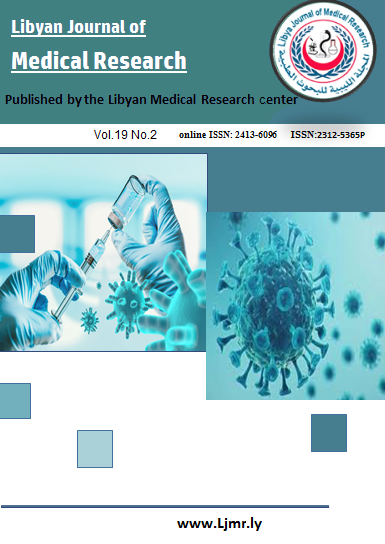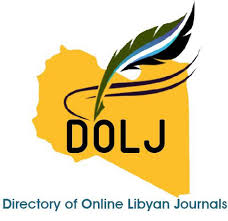The Correlation Between Chest CT Severity and Clinical Data Of Patients with COVID-19
DOI:
https://doi.org/10.54361/LJMR.19.2.21Keywords:
COVID-19, Chest CT Severity, RT-PCR, ICU Admission, Chronic IllnessAbstract
Purpose: The study aims to examine the correlation between clinical laboratory data, including RT-PCR results, and the severity of chest CT findings in COVID-19 patients. Early detection of severe cases can help reduce ICU admissions and improve patient outcomes. Data were collected from the laboratory at Tobruk Medical Center (TMC) and non-contrast high-resolution chest CT scans by a professional team. Materials and Methods: A retrospective analysis was conducted on 94 COVID-19 patients treated at The Medical Center of Tobruk in 2021. The study population included 58 males and 35 females, covering both young and elderly patients with and without chronic illnesses. Epidemiological, demographic, clinical, and outcome data—including ICU admissions and mortality—were analyzed using Microsoft Excel 2010. RT-PCR test results were obtained from the accredited Department of Laboratory Medicine at Tobruk Medical Center, which is responsible for PCR testing in the Tobruk region. The case definition followed the World Health Organization (WHO) interim guidance. Results: The results showed that 58% of the patients were male, while 35% were female. Patients were divided into two age groups: those below 40 years and those above 40 years. Among them, 4% of females and 7% of males were under 40, while 9% of females and 54% of males were above 40. The study also analyzed the presence of chronic illnesses: 27 patients had hypertension (BP), 5 had both hypertension and diabetes (DM), 1 had cerebrovascular accident (CVA), 18 had diabetes only, and 40 had no chronic diseases. Conclusion: This study highlights the significant correlation between chest CT severity and clinical data, particularly in older patients and those with chronic illnesses. Males exhibited a higher severity rate. The findings emphasize the importance of integrating laboratory and imaging data for early detection, which can aid in reducing ICU admissions and improving patient management.
Downloads
References
1. Malik YS, Kumar N, Sircar S, Kaushik R, Bhat S, Dhama K, Gupta P, Goyal K, Singh MP, Ghoshal U, El Zowalaty ME. Coronavirus disease pandemic (COVID-19): challenges and a global perspective. Pathogens. 2020 Jun 28;9(7):519.
2. Mahmoud AS, Dayhum AS, Rayes AA, Annajar BB, Eldaghayes IM. Exploiting epidemiological data to understand the epidemiology and factors that influence COVID-19 pandemic in Libya. World Journal of Virology. 2021 Jul 25;10(4):156.
3. Komurcuoglu B, Susam S, Batum Ö, Turk MA, Salik B, Karadeniz G, Senol G. Correlation between chest CT severity scores and clinical and biochemical parameters of COVID‐19 pneumonia. The Clinical Respiratory Journal. 2022 Jul;16(7):497-503.
4. Rani D, Bajaj H, Singh R. SARS-COV-2 (COVID-19) and role of real time Reverse Transcription Polymerase Chain Reaction (RT-PCR) in its diagnosis. Research Journal of Pharmacy and Technology. 2021;14(6):3437-40.
5. Machnicki S, Patel D, Singh A, Talwar A, Mina B, Oks M, Makkar P, Naidich D, Mehta A, Hill NS, Brown KK. The usefulness of chest CT imaging in patients with suspected or diagnosed COVID-19: a review of literature. Chest. 2021 Aug 1;160(2):652-70.
6. Adams, H. J., Kwee, T. C., Yakar, D., Hope, M. D., & Kwee, R. M. 2020. Chest CT imaging signature of coronavirus disease 2019 infection: in pursuit of the scientific evidence. Chest 158:1885-1895.
7. Ishfaq A, Farooq SM, Goraya A, Yousaf M, Gilani SA, Kiran A, Ayoub M, Javed A, Bacha R. Role of High-Resolution Computed Tomography chest in the diagnosis and evaluation of COVID-19 patients-A systematic review and meta-analysis. European journal of radiology open. 2021 Jan 1; 8:100350.
8. Ai T, Yang Z, Hou H, Zhan C, Chen C, Lv W, Tao Q, Sun Z, Xia L. Correlation of chest CT and RT-PCR testing for coronavirus disease 2019 (COVID-19) in China: a report of 1014 cases. Radiology. 2020 Aug;296(2): e32-40.
9. Kanne JP. Chest CT findings in 2019 novel coronavirus (2019-nCoV) infections from Wuhan, China: key points for the radiologist. Radiology. 2020 Apr;295(1):16-7.
10. Inui S, Fujikawa A, Jitsu M, Kunishima N, Watanabe S, Suzuki Y, Umeda S, Uwabe Y. Chest CT findings in cases from the cruise ship diamond princess with coronavirus disease (COVID-19). Radiology: Cardiothoracic Imaging. 2020 Mar 17;2(2):e200110.
11. Rubin GD, Ryerson CJ, Haramati LB, Sverzellati N, Kanne JP, Raoof S, Schluger NW, Volpi A, Yim JJ, Martin IB, Anderson DJ. The role of chest imaging in patient management during the COVID-19 pandemic: a multinational consensus statement from the Fleischner Society. Radiology. 2020 Jul;296(1):172-80.
12. Bernheim A, Mei X, Huang M, Yang Y, Fayad ZA, Zhang N, Diao K, Lin B, Zhu X, Li K, Li S. Chest CT findings in coronavirus disease-19 (COVID-19): relationship to duration of infection. Radiology. 2020 Jun;295(3):685-91.
13. Fang Y, Zhang H, Xie J, Lin M, Ying L, Pang P, Ji W. Sensitivity of chest CT for COVID-19: comparison to RT-PCR. Radiology. 2020 Aug;296(2):E115-7.
Downloads
Published
Issue
Section
License
Copyright (c) 2025 Nagwa. R. Bochwal , Huda M. Ibrahim , Wfa A. Nweh , Muhammad .Y.Alsawy, Ghanem .M. Jamal , Abdullh .A.Ali , Hamza. F. Atia , Fared .R. Fared (Author)

This work is licensed under a Creative Commons Attribution-NonCommercial-NoDerivatives 4.0 International License.
Open Access Policy
Libyan journal of medical Research (LJMR).is an open journal, therefore there are no fees required for downloading any publication from the journal website by authors, readers, and institution.
The journal applies the license of CC BY (a Creative Commons Attribution 4.0 International license). This license allows authors to keep ownership f the copyright of their papers. But this license permits any user to download , print out, extract, reuse, archive, and distribute the article, so long as appropriate credit is given to the authors and the source of the work.
The license ensures that the article will be available as widely as possible and that the article can be included in any scientific archive.
Editorial Policy
The publication of an article in a peer reviewed journal is an essential model for Libyan journal of medical Research (LJMR). It is necessary to agree upon standards of expected ethical behavior for all parties involved in the act of publishing: the author, the journal editorial, the peer reviewer and the publisher.
Any manuscript or substantial parts of it, submitted to the journal must not be under consideration by any other journal. In general, the manuscript should not have already been published in any journal or other citable form, although it may have been deposited on a preprint server. Authors are required to ensure that no material submitted as part of a manuscript infringes existing copyrights, or the rights of a third party.
Authorship Policy
The manuscript authorship should be limited to those who have made a significant contribution and intellectual input to the research submitted to the journal, including design, performance, interpretation of the reported study, and writing the manuscript. All those who have made significant contributions should be listed as co-authors.
Others who have participated in certain substantive aspects of the manuscript but without intellectual input should only be recognized in the acknowledgements section of the manuscript. Also, one of the authors should be selected as the corresponding author to communicate with the journal and approve the final version of the manuscript for publication in the LJMR.
Peer-review Policy
- All the manuscripts submitted to LJMR will be subjected to the double-blinded peer-review process;
- The manuscript will be reviewed by two suitable experts in the respective subject area.
- Reports of all the reviewers will be considered while deciding on acceptance/revision or rejection of a manuscript.
- Editor-In-Chief will make the final decision, based on the reviewer’s comments.
- Editor-In-Chief can ask one or more advisory board members for their suggestions upon a manuscript, before making the final decision.
- Associate editor and review editors provide administrative support to maintain the integrity of the peer-review process.
- In case, authors challenge the editor’s negative decision with suitable arguments, the manuscript can be sent to one more reviewer and the final decision will be made based upon his recommendations.














